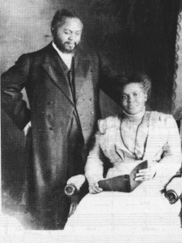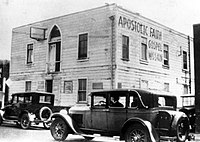C. L. Seymore
I am here to bring the answers to prayer of The Azuza Street Revival .
Support it Here : www.gofundme.com/MatchUsToday
Read About it Here: sites.google.com/site/lcorpsnonprofit/the-interfaith-connection-of-lcorps
Study It Here:
The Azusa Street Revival was a historic revival meeting that took place in Los Angeles, California, and is the origin of the Pentecostal movement.[1] It was led by William J. Seymour, an African American preacher. It began with a meeting on April 9, 1906, and continued until roughly 1915. The revival was characterized by ecstatic spiritual experiences accompanied by claims of physical healing miracles,[2] dramatic worship services, speaking in tongues, and inter-racial mingling. The participants were criticized by the secular media and Christian theologians for behaviors considered to be outrageous and unorthodox, especially at the time. Today, the revival is considered by historians to be the primary catalyst for the spread of Pentecostalism in the 20th century.
Background
Los Angeles
In 1905, William J. Seymour, the one-eyed 34-year-old son of freed slaves, was a student of well-known Pentecostal preacher Charles Parham and an interim pastor for a small holiness church in Topeka, Kansas.[3] Neely Terry, an African American woman who attended a small holiness church pastored by Julia Hutchins in Los Angeles, made a trip to visit family in Houston late in 1905.[4] While in Houston, she visited Seymour's church, where he preached on receiving the Holy Spirit with the evidence of speaking in other tongues, and though he had not experienced this personally, Terry was impressed with his character and message. Once home in California, Terry suggested that Seymour be invited to speak at the local church.[5] Seymour received and accepted the invitation in February 1906, and he received financial help and a blessing from Parham for his planned one-month visit.[4][6]
Seymour arrived in Los Angeles on February 22, 1906,[7][8] and within two days was preaching at Julia Hutchins' church at the corner of Ninth Street and Santa Fe Avenue.[5] During his first sermon, he preached that speaking in tongues was the first biblical evidence of the inevitable infilling in the Holy Spirit.[9] On the following Sunday, March 4, he returned to the church and found that Hutchins had padlocked the door.[10] Elders of the church rejected Seymour's teaching, primarily because he had not yet experienced the blessing about which he was preaching.[4] Condemnation of his message also came from the Holiness Church Association of Southern California with which the church had affiliation.[6] However, not all members of Hutchins' church rejected Seymour's preaching. He was invited to stay in the home of congregation member Edward S. Lee, and he began to hold Bible studies and prayer meetings there.
North Bonnie Brae Street[edit]
Seymour and his small group of new followers soon relocated to the home of Richard and Ruth Asberry at 216 North Bonnie Brae Street.[7] White families from local holiness churches began to attend as well. The group would get together regularly and pray to receive the baptism of the Holy Spirit. On April 9, 1906, after five weeks of Seymour's preaching and prayer, and three days into an intended 10-day fast,[10] Edward S. Lee spoke in tongues for the first time.[11][12] At the next meeting, Seymour shared Lee's testimony and preached a sermon on Acts 2:4 and soon six others began to speak in tongues as well,[6][11] including Jennie Moore, who would later become Seymour's wife. A few days later, on April 12, Seymour spoke in tongues for the first time after praying all night long.[13][14]
News of the events at North Bonnie Brae St. quickly circulated among the African American, Latino and White residents of the city, and for several nights, various speakers would preach to the crowds of curious and interested onlookers from the front porch of the Asberry home. Members of the audience included people from a broad spectrum of income levels and religious backgrounds. Hutchins eventually spoke in tongues as her whole congregation began to attend the meetings. Soon the crowds became very large and were full of people speaking in tongues, shouting, singing and moaning. Finally, the front porch collapsed, forcing the group to begin looking for a new meeting place.[12] A resident of the neighborhood described the happenings at 216 North Bonnie Brae with the following words:
Azusa Street
Conditions
The group from Bonnie Brae Street eventually discovered an available building at 312 Azusa Street in downtown Los Angeles, which had originally been constructed as an African Methodist Episcopal Church in what was then an impoverished part of town.[12] The rent was $8.00 per month.[15] A newspaper referred to the downtown Los Angeles building as a "tumble down shack". Since the church had moved out, the building had served as a wholesale house, a warehouse, a lumberyard, stockyards, a tombstone shop, and had most recently been used as a stable with rooms for rent upstairs. It was a small, rectangular, flat-roofed building, approximately 60 feet (18 m) long and 40 feet (12 m) wide, totaling 2,400 square feet (220 m2), sided with weathered whitewashed clapboards. The only sign that it had once been a house of God was a single Gothic-style window over the main entrance.[12]
Discarded lumber and plaster littered the large, barn-like room on the ground floor.[16][17] Nonetheless, it was secured and cleaned in preparation for services. They held their first meeting on April 14, 1906.[11][14][18] Church services were held on the first floor where the benches were placed in a rectangular pattern. Some of the benches were simply planks put on top of empty nail kegs.[10][12] There was no elevated platform, as the ceiling was only eight feet high.[18]Initially there was no pulpit. Frank Bartleman, an early participant in the revival, recalled that "Brother Seymour generally sat behind two empty shoe boxes, one on top of the other. He usually kept his head inside the top one during the meeting, in prayer. There was no pride there.... In that old building, with its low rafters and bare floors..."[6]
The second floor at the now-named Apostolic Faith Mission[11] housed an office and rooms for several residents including Seymour and his new wife, Jennie. It also had a large prayer room to handle the overflow from the altar services below. The prayer room was furnished with chairs and benches made from California Redwood planks, laid end to end on backless chairs.[6]
By mid-May 1906, anywhere from 300[4] to 1,500 people would attempt to fit into the building. Since horses had very recently been the residents of the building, flies constantly bothered the attendees.[18] People from a diversity of backgrounds came together to worship: men, women, children, black, white, Hispanic, Asian, rich, poor, illiterate, and educated.[14] People of all ages flocked to Los Angeles with both skepticism and a desire to participate.[4][18] The intermingling of races and the group's encouragement of women in leadership was remarkable, as 1906 was the height of the "Jim Crow" era of racial segregation,[11] and fourteen years prior to women receiving suffrage in the United States.
Services and worship[edit]
Worship at 312 Azusa Street was frequent and spontaneous with services going almost around the clock. Among those attracted to the revival were not only members of the Holiness Movement, but also Baptists, Mennonites, Quakers, and Presbyterians.[15] An observer at one of the services wrote these words:





Comments
Post a Comment